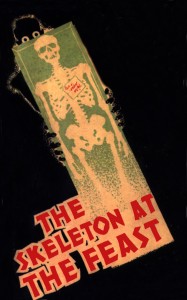 All Carved Up: Performing Autopsies on the Great Bodies of Crime Fiction
All Carved Up: Performing Autopsies on the Great Bodies of Crime Fiction
When I first decided to write an article about this short-lived publishing house I believed that reading the 30 titles published between 1930 and 1933 would be an easy, delightful task. After trudging through about five, I amended my expectations to scanning all 30 and possibly picking interesting phrases to use as quotes. After scanning 18 or thereabouts, the jacket blurbs suddenly seemed to encompass all the info I needed, and finally, I gave up entirely and decided that yes, the best thing about these books is the dust jacket art, as suspected.
When first encountered, Mystery League titles were being sold from $12 on up to $20 if in DJ and in near fine condition. The low cost was due to the contents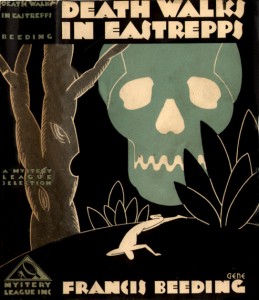 being so awful that the books themselves were not of much value. Sure there are a few respected authors of the day, Edgar Wallace, and Francis Beeding-author of the Haycraft-Queens selection Death walks in Eastrepps– being two, but most authors penned incomprehensible plots with overly dramatic villains, monsters, and the requisite damsel in distress. Not that this isn’t exquisitely horrible in a way that makes them fun to read, if you consider the books to be parodies of fine detective literature.
being so awful that the books themselves were not of much value. Sure there are a few respected authors of the day, Edgar Wallace, and Francis Beeding-author of the Haycraft-Queens selection Death walks in Eastrepps– being two, but most authors penned incomprehensible plots with overly dramatic villains, monsters, and the requisite damsel in distress. Not that this isn’t exquisitely horrible in a way that makes them fun to read, if you consider the books to be parodies of fine detective literature.
But oh, that dust jacket art! That’s what turns collectors’ heads and makes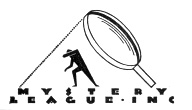 Mystery Leagues more and more valuable. The jackets are rendered in a stark Art Deco style with basic colors, black, white and grey with a third color; green, red, blue or yellow. It is this artwork that caught my eye and led me and everyone else, it seemed, to collect at the same time. The books began an upward spiral costing $100 a pop for a fine/near fine condition book. I had no idea how many books were published by The Mystery League with this style of art or who designed the jackets until a wonderful article in a 1992 Firsts Magazine by Ellen Nehr clued me in. The artist for most of the jackets was a mysterious fellow named Gene; his signature is prominent on the titles. At the time of that article it was unknown if Gene
Mystery Leagues more and more valuable. The jackets are rendered in a stark Art Deco style with basic colors, black, white and grey with a third color; green, red, blue or yellow. It is this artwork that caught my eye and led me and everyone else, it seemed, to collect at the same time. The books began an upward spiral costing $100 a pop for a fine/near fine condition book. I had no idea how many books were published by The Mystery League with this style of art or who designed the jackets until a wonderful article in a 1992 Firsts Magazine by Ellen Nehr clued me in. The artist for most of the jackets was a mysterious fellow named Gene; his signature is prominent on the titles. At the time of that article it was unknown if Gene 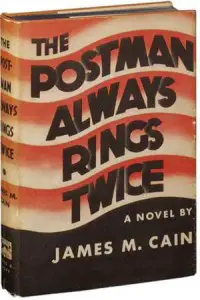 were male or female, but later in Jackets Required, (Heller & Chwast Chronicle 1995), Gene is identified as Eugene Thurston. And that is all I can find about him. On the other hand, the other artist responsible for some of the jackets, Arthur Hawkins, later went on to have a very illustrious career in design and is the man responsible for the fantastic art moderne jacket for James M. Cain’s The Postman Always Rings Twice.
were male or female, but later in Jackets Required, (Heller & Chwast Chronicle 1995), Gene is identified as Eugene Thurston. And that is all I can find about him. On the other hand, the other artist responsible for some of the jackets, Arthur Hawkins, later went on to have a very illustrious career in design and is the man responsible for the fantastic art moderne jacket for James M. Cain’s The Postman Always Rings Twice.
The Mystery League started its ill-fated publishing house in 1929 and the first title The Hand of Power by Edgar Wallace was released in 1930. They announced the intention of printing westerns, romances and adventures but it never came to be. The idea behind this publishing venture was inexpensive product. They charged just 50 cents each for a beautiful silk finished hardcover book and they could only be purchased at United Cigar Stores and Neve, later Owl Drug Stores. The selling of books in places other than bookstores might account for the indifferent writing. If the target audience was assumed to be a less sophisticated literary group, perhaps the publishers didn’t feel the need to pay for decent authors.
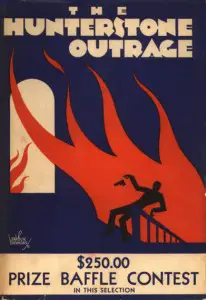
As an original marketing ploy, which has been since utilized frequently by current publishers, each title had a teaser at the end of the book, a chapter from the next book in line for publication. They also added a Baffle Contest. The Baffle Books put out by the Doubleday Crime Club were a big hit at the time so Mystery League apparently stole the idea for their line and placed a contest in the back of The Hunterstone Outrage. The baffle was 11 pages complete with a crime scene map and witness statements. $250 in gold was awarded and divided among four lucky Sherlocks who ‘most cleverly, logically, and concisely solve the first Baffle Case.’ Only 3 Baffle Cases were offered and only the first 2 gave the solution to readers. Another short-lived enterprise of The Mystery League was a magazine edited by Frederic Dannay and Manfred Lee, who wrote as Ellery Queen. Just four issues were produced, and if any of you out there have a copy of one, let me know!
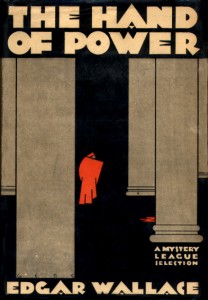
As far as quality writing–I tried following the plot of the first release, The Hand of Power by Edgar Wallace, and from what I deduced it involved a secret society with melodramatics that seemed incredibly boring in their telling. The dust jacket had a much more colorful description of a character in the book: “La Florette, thin lipped pseudo French star who spelled sin, $in!’ Tantalizing jacket, but disappointing within. However, there are staunch supporters of Edgar Wallace who applaud all his work, so perhaps this particular title is only a personal dislike, and not indicative of the overall horrid writing skills of authors who compiled the Mystery League list.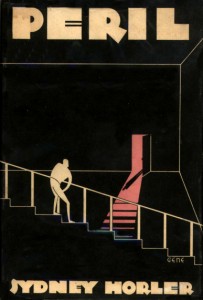 Edgar Wallace, contributed two titles, and quite a few were written and published first in the UK and then published here. These thrillers have the sensibilities of a bygone era whose heroes were upper class Englishmen out to do the noble thing and beat back spies, diabolical criminal masterminds, and possible supernatural foes. For example, although down and out due to the Depression, the hero inPeril by Sydney Horler, despite being whisked off the street, fed and clothed by a criminal mastermind, resists attempts to be used by his benefactor. Our stalwart British gentleman will do just so many things not to be homeless, and stealing from a lady is not one of them, by gad! In various others such as The Tunnel Mystery by J. C. Lenehan, the typical detective
Edgar Wallace, contributed two titles, and quite a few were written and published first in the UK and then published here. These thrillers have the sensibilities of a bygone era whose heroes were upper class Englishmen out to do the noble thing and beat back spies, diabolical criminal masterminds, and possible supernatural foes. For example, although down and out due to the Depression, the hero inPeril by Sydney Horler, despite being whisked off the street, fed and clothed by a criminal mastermind, resists attempts to be used by his benefactor. Our stalwart British gentleman will do just so many things not to be homeless, and stealing from a lady is not one of them, by gad! In various others such as The Tunnel Mystery by J. C. Lenehan, the typical detective 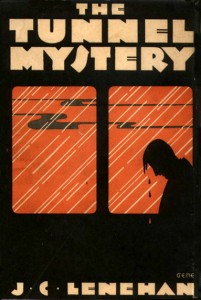 of Scotland Yard trails the murderer; and in Jack O’Lantern by George Goodchild, Detective Inspector Wench tries to keep an honorable Judge from being hounded by a hypnotic criminal who may be a dead prisoner the judge sent to the gallows. It has a nice trick ending, so I suppose I can name this one of the better in the catalog.
of Scotland Yard trails the murderer; and in Jack O’Lantern by George Goodchild, Detective Inspector Wench tries to keep an honorable Judge from being hounded by a hypnotic criminal who may be a dead prisoner the judge sent to the gallows. It has a nice trick ending, so I suppose I can name this one of the better in the catalog.
Some rather Gothic tales seem to have been hatched by Mystery League authors. Vampire bats are swooping around a castle in one tale, a monster who can scale the tower walls of the french chateau plagues another, and black magic is suspected in a third.
A trend most evident was the evil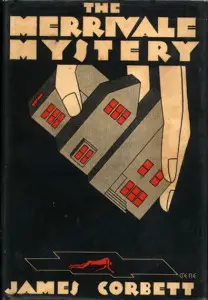 house or castle theme. Boy did they know how to erect the most sinister structures back then! The Merrivale Mystery by James Corbett gives us Merrivale Hall and a family ‘whose wealth makes them a law unto themselves,’ and where ‘the members of the family only met for meals in the sumptuous dining room where silence, cold and bitter, was the invariable rule.’ Another luring dust jacket blurb. One family member meets his end in the library. Another fabulously diabolical house seems to put its occupants to sleep never to awake again, hence the title The House of Sudden Sleep by John Hawk. The Mystery of Burnleigh Manor by Walter livingston explores why the
house or castle theme. Boy did they know how to erect the most sinister structures back then! The Merrivale Mystery by James Corbett gives us Merrivale Hall and a family ‘whose wealth makes them a law unto themselves,’ and where ‘the members of the family only met for meals in the sumptuous dining room where silence, cold and bitter, was the invariable rule.’ Another luring dust jacket blurb. One family member meets his end in the library. Another fabulously diabolical house seems to put its occupants to sleep never to awake again, hence the title The House of Sudden Sleep by John Hawk. The Mystery of Burnleigh Manor by Walter livingston explores why the 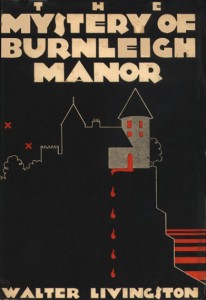 manor has been falling to ruin ever since its owner was found dead in his study. Evil is said to permeate the walls. And what a house this is, with secret passageways, ghosts that are killing houseguests, and egyptian treasure. The plot provides one of the funniest lines not intended as humor, due to the author’s propensity for odd character names. In describing the aftermath of an accident he writes: ‘Burnleigh dispatched Gloom in search of a doctor’ and goes on to say ‘If I had been really clever I would have carefully noted where Gloom was when I came back, but then I do not believe people are ever as sagacious or astute in real life as they are supposed to be in the mystery novels.’ The Mystery of the Villa Sineste also by Walter livingston is set in Italy. ‘Like Castle Dracula in Bram Stoker’s tale, its damp corridors and vaulted chambers housed a saturnine master in Dr. di Ponari who had talents that bordered on the supernatural.’
manor has been falling to ruin ever since its owner was found dead in his study. Evil is said to permeate the walls. And what a house this is, with secret passageways, ghosts that are killing houseguests, and egyptian treasure. The plot provides one of the funniest lines not intended as humor, due to the author’s propensity for odd character names. In describing the aftermath of an accident he writes: ‘Burnleigh dispatched Gloom in search of a doctor’ and goes on to say ‘If I had been really clever I would have carefully noted where Gloom was when I came back, but then I do not believe people are ever as sagacious or astute in real life as they are supposed to be in the mystery novels.’ The Mystery of the Villa Sineste also by Walter livingston is set in Italy. ‘Like Castle Dracula in Bram Stoker’s tale, its damp corridors and vaulted chambers housed a saturnine master in Dr. di Ponari who had talents that bordered on the supernatural.’
Van Wyck Mason’s Spider House is deliberately malevolent. ‘A curious household this, pleasant homey sort of place such as Eugene O’Neill would have been fascinated with.’ The owner so fears for his life that he has booby trapped his home in order to keep would-be assassins at bay. The Depression again plays a tiny role, whereas most of the other titles ignore its existence. The owner was a former stockbroker blamed for many of his clients ruin. No wonder he fears for his life! Big surprise, the house loses the battle and the stockbroker dies. Even skyscrapers were not immune to the cursed house syndrome. An entrepreneur constructs a bungalow on the very tip of a skyscraper where during daylight hours office workers slave away, but at night the entire building closes down so the millionaire can have his privacy. He can’t escape the evil house problem, however. A Victrola keeps playing when no one is at home and it seems as though some African voodoo is at work.
household this, pleasant homey sort of place such as Eugene O’Neill would have been fascinated with.’ The owner so fears for his life that he has booby trapped his home in order to keep would-be assassins at bay. The Depression again plays a tiny role, whereas most of the other titles ignore its existence. The owner was a former stockbroker blamed for many of his clients ruin. No wonder he fears for his life! Big surprise, the house loses the battle and the stockbroker dies. Even skyscrapers were not immune to the cursed house syndrome. An entrepreneur constructs a bungalow on the very tip of a skyscraper where during daylight hours office workers slave away, but at night the entire building closes down so the millionaire can have his privacy. He can’t escape the evil house problem, however. A Victrola keeps playing when no one is at home and it seems as though some African voodoo is at work.
 One of my favorites out of this group is The Curse of Doone by Sydney Horler. Oh brother, does this have it all! Secret passageways, giant flying vampire bats, German spies seeking a secret invention and a possible damsel in distress, or is she in on it? A typical passage describes a villain of huge proportions: ‘Gusta Straube was a good type of the Teutonic feminine…. With the monocle screwed into her left eye she looked forbidding and sinister: the glass could not hide the basilisk quality of her stare…Her face was heavy. the flesh, creamy in tint, had a dull, lifeless appearance. One might have expected the eyes of such a woman to be glazed but instead they were reptilian. Through the glass of the monocle the left one appeared to have a stupefying effect upon all who looked her way.’ For smart and funny look at this title read the splendid Gun In Cheek–Coward, 1981– by Bill Pronzini which explores the worst in mystery fiction, or best, depending upon your taste!
One of my favorites out of this group is The Curse of Doone by Sydney Horler. Oh brother, does this have it all! Secret passageways, giant flying vampire bats, German spies seeking a secret invention and a possible damsel in distress, or is she in on it? A typical passage describes a villain of huge proportions: ‘Gusta Straube was a good type of the Teutonic feminine…. With the monocle screwed into her left eye she looked forbidding and sinister: the glass could not hide the basilisk quality of her stare…Her face was heavy. the flesh, creamy in tint, had a dull, lifeless appearance. One might have expected the eyes of such a woman to be glazed but instead they were reptilian. Through the glass of the monocle the left one appeared to have a stupefying effect upon all who looked her way.’ For smart and funny look at this title read the splendid Gun In Cheek–Coward, 1981– by Bill Pronzini which explores the worst in mystery fiction, or best, depending upon your taste!
And finally, an aptly titled The House of Terror by Edward Woodward, Quite equals The Curse of Doone in bizarre plot trappings. A damsel in distress, as many of these books delight in, has inherited a brooding mansion where a man dies by poison dart–maybe–and there is a world destroying invention hidden–somewhere–a maniacal dwarf has disappeared onto the moors–possibly–a tree trunk is revealed to provide a passageway to the house which is how the murderer entered–they guess–a friend of the new mistress is kidnapped and carried away by the groundskeeper —it is thought–and howling hounds roam the grounds–perhaps. Considering all the evil surrounding this house a quip about the new mistress by the hero Fenchurch is a bit of an understatement, ‘Well if she’s going to make the Manor her home she’ll have a bit of spring cleaning to do.’
Quite equals The Curse of Doone in bizarre plot trappings. A damsel in distress, as many of these books delight in, has inherited a brooding mansion where a man dies by poison dart–maybe–and there is a world destroying invention hidden–somewhere–a maniacal dwarf has disappeared onto the moors–possibly–a tree trunk is revealed to provide a passageway to the house which is how the murderer entered–they guess–a friend of the new mistress is kidnapped and carried away by the groundskeeper —it is thought–and howling hounds roam the grounds–perhaps. Considering all the evil surrounding this house a quip about the new mistress by the hero Fenchurch is a bit of an understatement, ‘Well if she’s going to make the Manor her home she’ll have a bit of spring cleaning to do.’
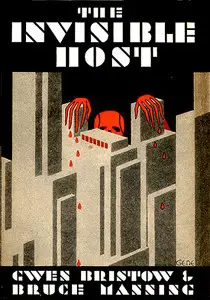 On the Atlantic side, the husband and wife team of Gwen Bristow and Bruce Manning produced a few of the more readable novels starting with The Invisible Host whose plot pre-dated Agatha Christie?s And Then There Were None (the final title used for this book) by 9 years. 8 people receive invitations to a penthouse party. After all arrived they’re told over a radio that they cannot leave and the doors are electrified if they dare to try. After re-reading this plot it struck me that as a young teenager I had read it and brought a copy into a mystery bookstore in Philly to trade for a couple of paperbacks, and I remember how excited the owner was when he saw what title I had brought him. No collector I, then! The Gutenberg Murders is a biblio mystery which
On the Atlantic side, the husband and wife team of Gwen Bristow and Bruce Manning produced a few of the more readable novels starting with The Invisible Host whose plot pre-dated Agatha Christie?s And Then There Were None (the final title used for this book) by 9 years. 8 people receive invitations to a penthouse party. After all arrived they’re told over a radio that they cannot leave and the doors are electrified if they dare to try. After re-reading this plot it struck me that as a young teenager I had read it and brought a copy into a mystery bookstore in Philly to trade for a couple of paperbacks, and I remember how excited the owner was when he saw what title I had brought him. No collector I, then! The Gutenberg Murders is a biblio mystery which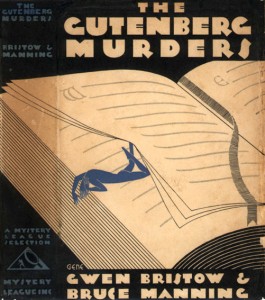 accounts for this one being more sought after than most of the others. Some of the outrageous plot points are; cases of apparent spontaneous combustion; the unusual use of the greek myth of Medea; a convoluted last will; and nine leaves of the famous Gutenberg Bible. Plus, it’s fun to read. As is The Mardi Gras Murders which has the most amazingly odd murders I have encountered. The first takes place in a Mardi Gras ball where everyone is dressed as the devil and no one knows who is in attendance. Tthe members of the Dis (club) only know themselves and one other member, the one they were allowed to invite. The hostess believes that the victim is one person only when unmasked to find it’s quite another. A new murder occurs during the Mardi Gras parade on a float–a man dressed as a goldfish hanging in a glass bowl is inexplicably shot and killed although the glass has not a hole or crack in it! Now that is some murder scene! The third title by the couple, Two and Two Make Twenty-Two, is the only dust jaacket with yellow and brown as its main hues. I used the skeleton on the top as part of the masthead to a newsletter I wrote back in the late 90s. It is my favorite cover of the Mystery Leagues.
accounts for this one being more sought after than most of the others. Some of the outrageous plot points are; cases of apparent spontaneous combustion; the unusual use of the greek myth of Medea; a convoluted last will; and nine leaves of the famous Gutenberg Bible. Plus, it’s fun to read. As is The Mardi Gras Murders which has the most amazingly odd murders I have encountered. The first takes place in a Mardi Gras ball where everyone is dressed as the devil and no one knows who is in attendance. Tthe members of the Dis (club) only know themselves and one other member, the one they were allowed to invite. The hostess believes that the victim is one person only when unmasked to find it’s quite another. A new murder occurs during the Mardi Gras parade on a float–a man dressed as a goldfish hanging in a glass bowl is inexplicably shot and killed although the glass has not a hole or crack in it! Now that is some murder scene! The third title by the couple, Two and Two Make Twenty-Two, is the only dust jaacket with yellow and brown as its main hues. I used the skeleton on the top as part of the masthead to a newsletter I wrote back in the late 90s. It is my favorite cover of the Mystery Leagues.

Some other harder-boiled stories include a band of cutthroat gangsters terrorizing guests on a houseboat in the Stingaree Murders by W. Shepard Pleasants, Rufus Gilmore’s The Ebony Bed Murder a locked room mystery where the corpse is a goldigger nicknamed Henry the Eight due to all of her husbands, and Murder in the French Room by Helen Joan Hultman,where the corpse is draped in lingerie and found in a swank department store. The crime is solved by the store Dick–or in this case Jane! A female detective for once.
I have to admit that one of the more surprising plot elements in many of the books is drug use and drug smuggling. These books are permeated with characters sniffing cocaine, today’s drug of choice, and selling opium, a more recognized illegal substance for that day and time. I didn’t suppose drug use was a open secret back then, or used in plots. Spider House by Van Wyck Mason has a morphine addict; The Secret of High Eldersham seems to have been drug smuggling; a quote from The Tunnel Mystery creates a nice picture: ‘The back of his hand was near his nostrils and he was sniffing with semi-demented energy;’ and Jack O’ lantern’s main character uses and abuses cocaine which facilitates in part the surprise denouement. More favorite quotes come from The Curse of Doone: ‘These had faces which an opium crazed artist might have painted. Here all the passions were uncontrolled: they were mixing with their own kind: stimulated by cocaine and other drugs, the lid was off, the veil was torn aside.’ Of course, the difference here is in the depiction of drug use, especially cocaine. It is not one of glorification or acceptance, as some might argue today’s depictions are. The character who uses drugs is depraved, immoral, and downright demonic. They definitely do not go on a one man comedy tour and charge big bucks for people to watch their drug induced train wreck life!

Another aspect of the novels that is unavoidable, is racism. Of every type–from Far Easterners portrayed as sly and shifty to the typical stereotypes of African-Americans as stupid and lazy. In The Mardi Gras Murder the police keep a black butler in jail even though they know he didn’t do it just because they suspect he may know more than he is telling. The butler’s speech is in the usual vernacular of old Shirley Temple movies–the yes suh type of thing. And the white characters are not immune from using the worst racial epitaph in casual conversation. A Mardi Gras float description is tame compared to others: ‘Their ears were assailed by a moving sea of black faces. Along the street in marvelous savage panoply, rode the ruler of the negro Carnival, the Sulu King, grandly decked in a grass skirt and strings of beads and feathers and flowers leading a line of floats on which rode singing darky revelers dressed like their cannibal forbears.’ It begs the contraversial question, should old texts be altered in terms of racism, sexism, any ism out there? And the answer is no. No matter how disgusting the views on women or minorities were, that was the reality when written. To purge books of distastefulness ignores the problems, as if they never existed. Better to read as written and discuss why these kinds of things are no long tolerated in print or life.
There can be no doubt that all of these books are very dated not only in racist content but in general plot and detecting skills. But one can overlook all but the most blatant racism to enjoy the outlandish storylines and characters with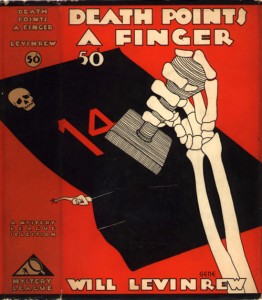 names as wacky as the stories. Some standout character names include Cuthbery Merrivale, Rupert Dykeminster, Doctor Ambrose Devinne, David Ribblesdale, Dorothy Vroom, Sergeant Grimwade, Ezra Apps, and just plain Zweig. Unfortunately, readers must have been a bit more sophisticated than the publishers thought because after almost 4 years and 30 titles they abruptly stopped publishing. The last title became Death Points a Finger although at the back of this title there is an ad for the next in the series-David Frome’s Death Holds the Key, which never came to be .
names as wacky as the stories. Some standout character names include Cuthbery Merrivale, Rupert Dykeminster, Doctor Ambrose Devinne, David Ribblesdale, Dorothy Vroom, Sergeant Grimwade, Ezra Apps, and just plain Zweig. Unfortunately, readers must have been a bit more sophisticated than the publishers thought because after almost 4 years and 30 titles they abruptly stopped publishing. The last title became Death Points a Finger although at the back of this title there is an ad for the next in the series-David Frome’s Death Holds the Key, which never came to be .
Any number of reasons could be fingered as the cause for The Mystery League’s demise, but the Depression probably was the greatest factor. It’s tough enough for publishers today, imagine trying to survive the worst economic catastrophe  of our time. What appeals to many collectors of Mystery Leagues, besides the luscious jackets is the finite amount you need to amass. Opposed to collecting Doubleday Crime Clubs where the 1930’s alone produced hundreds of titles–all a collector has to do with Mystery Leagues is find 30. Not as easy as it seems now that the collecting world discovered them and not so inexpensive either. It took us 3 years to amass all thirty although for a year or so we only needed a couple of titles, The Gutenberg Murders, The Bungalow on the Roof and the one that drove me bonkers looking in antiquarian dealers catalogs, on Bookfinder.com, and at book fairs: Murder in the French Room. The same darn titles kept cropping up: we have 3 Spider house?s, 2 Peril’s, 2 Stingaree Murders, and have sold several other duplicates over the years. Because of course, you upgrade! You grab the first copy of a title you find, with frayed spine or worse-chips, and when you find another copy with less faults, you exchange it.
of our time. What appeals to many collectors of Mystery Leagues, besides the luscious jackets is the finite amount you need to amass. Opposed to collecting Doubleday Crime Clubs where the 1930’s alone produced hundreds of titles–all a collector has to do with Mystery Leagues is find 30. Not as easy as it seems now that the collecting world discovered them and not so inexpensive either. It took us 3 years to amass all thirty although for a year or so we only needed a couple of titles, The Gutenberg Murders, The Bungalow on the Roof and the one that drove me bonkers looking in antiquarian dealers catalogs, on Bookfinder.com, and at book fairs: Murder in the French Room. The same darn titles kept cropping up: we have 3 Spider house?s, 2 Peril’s, 2 Stingaree Murders, and have sold several other duplicates over the years. Because of course, you upgrade! You grab the first copy of a title you find, with frayed spine or worse-chips, and when you find another copy with less faults, you exchange it.
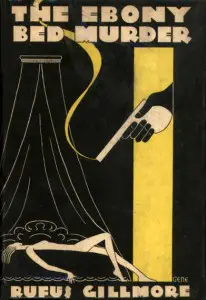
Our title in the worst condition is The False Purple by the prolific Sydney Horler. We lucked upon that one hidden among The Black Orchid bookshop’s gems and have not seen another copy since. Hey you take what you can get!
Far from spending 20 bucks a shot for a F/F book we have upgraded a few and spent about 100 bucks for each. But a bargain is still out there. We found some titles that were far from perfect but certainly VG/NF for only 10 bucks apiece and as we haven’t seen other copies since in any better condition, these are the ones we stick with.
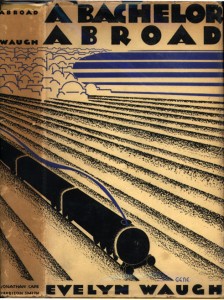
Although Gene’s life is still a mystery, we do know that he designed jackets for other publishers during this time frame. We have been trying to find every jacket that he illustrated but since we have no idea how many or what the titles may be, we can only go by sight. After encountering a Evelyn Waugh with a Gene dust jacket I thought my husband would have a coronary. Instead we went into debt to own it.
This is nothing compared to the 20’s style cocktail party we threw to celebrate the final acquisition. Let’s just say that the spirit of Gene and The Mystery League authors lived on in an absinthe cocktail, The Corpse Reviver.
Since I first wrote this article many moons ago, I have seen some of the mystery leagues go down a bit in value–probably due to the economic times and the fever of collecting isn’t has high as it was. But, the harder ones to find are still above 100 bucks in fine condition.
Also, my husband and I have collected a couple more dust jackets illustrated by Gene not part of the Mystery Leagues, one is a reprint for The Amazing Web by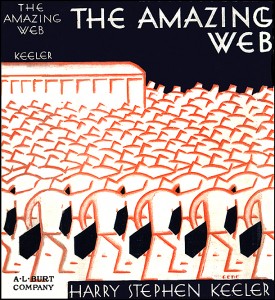 Harry Stephen Keeler–a much sought after author due to his incomprehensible plots and outlandish characters. Therefore, although not a first edition, the reprint in dust jacket fetched a decent price, but not outlandish.
Harry Stephen Keeler–a much sought after author due to his incomprehensible plots and outlandish characters. Therefore, although not a first edition, the reprint in dust jacket fetched a decent price, but not outlandish.
To find any of the titles within the Mystery League publications, try your local used bookstores, or online used bookstores, and bookfinder.com.

You have done an exemplary job of information gathering in this genre. These books are difficult to find and most of us will never have the opportunity to see these books in person. I own ” The Postman Always Rings Twice” as seen above and will be pulling it off the shelf to appreciate the book for it’s literary value and literally, for the cover art. Thank you for the info and the pics.
I have a copy of the Murder in the French Room however, it does not have a jacket on it.
Where can I find a list of the entire series?